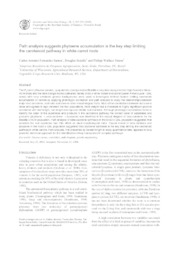Path analysis suggests phytoene accumulation is the key step limiting the carotenoid pathway in white carrot roots.
Path analysis suggests phytoene accumulation is the key step limiting the carotenoid pathway in white carrot roots.
Author(s): SANTOS, C. A. F.; SENALIK, D.; SIMON, P. W.
Summary: Two F 2 carrot (Daucus carota L.) populations (orange rooted Brasilia x very dark orange rooted High Carotene Mass - HCM cross and the dark orange rooted cultivated variety B493 x white rooted wild carrot Queen Anne’s Lace - QAL cross) with very unrelated genetic backgrounds were used to investigate intrinsic factors limiting carotenoid accumulation in carrots by applying phenotypic correlation and path analysis to study the relationships between major root carotenes, root color and several other morphological traits. Most of the correlations between traits were close and agreed in sign between the two populations. Root weight had a moderate to highly significant positive correlation with leaf length, root length and top and middle root diameter. Although phenotypic correlations failed to identify the order of the substrates and products in the carotenoid pathway the correct order of substrates and products (phytoene zeta-carotene lycopene) was identified in the causal diagram of beta-carotene for the Brasilia x HCM population. Path analysis of beta-carotene synthesis in the B493 x QAL population suggested that selection for root carotenes had little effect on plant morphological traits. Causal model of beta-carotene and lycopene in the B493 x QAL population suggested that phytoene synthesis is the key step limiting the carotenoid pathway in white carrots. Path analysis, first presented by Sewall Wright to study quantitative traits, appears to be a powerful statistical approach for the identification of key compounds in complex pathways.
Publication year: 2005
Types of publication: Journal article
Unit: Embrapa Semi-arid Region
Observation
Some of Embrapa's publications are published as ePub files. To read them, use or download one of the following free software options to your computer or mobile device. Android: Google Play Books; IOS: iBooks; Windows and Linux: Calibre.
Access other publications
Access the Agricultural Research Database (BDPA) to consult Embrapa's full library collection and records.
Visit Embrapa Bookstore to purchase books and other publications sold by Embrapa.

